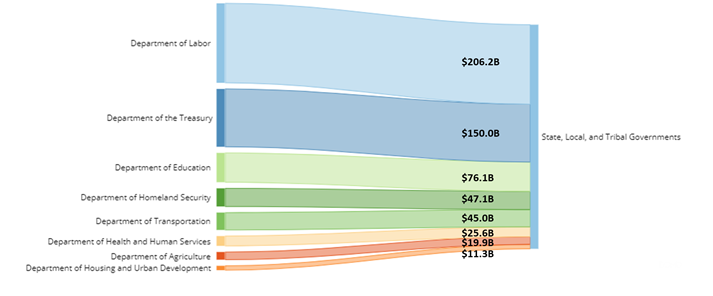
According to the Pandemic Response Accountability Committee (PRAC)’s website, Government agencies and education institutions have about $5 trillion in federal government funds to use with the CARES Act and other related pandemic relief legislation. Do you know about the technology provisions on those funds?
Figure 1. The Top 10 Agencies and Their Funding Categories [funding for all pandemic response legislation except the American Rescue Plan (ARP) Source: Pandemicoversight.gov]

Coronavirus Aid, Relief, and Economic Security Act (CARES)
According to the Treasury website, the CARES Act was signed on March 27, 2020 and, according to the U.S. Department of Education, is an approximately $2.2 trillion stimulus package that created the Paycheck Protection Program (PPP) for eligible small businesses. It temporarily expanded unemployment, provided, to the extent eligible, tax rebates to individuals, funding to federal agencies, relief to corporations, payroll support for airline workers, and aid to state and local governments. More information and key program dates can be found using the Federal Register Guidance Document.
For Educational Institutions
Certain higher education institutions may be eligible for support [under the CARES Act], complete guidance can be found in the Elementary and Secondary School Emergency Relief Fund Frequently Asked Questions about the Elementary and Secondary School Emergency Relief Fund (ESSER Fund). I will provide just a highlight of the Higher Education Emergency Relief Fund (HEERF) which, according to the Office of Postsecondary Education on the U.S. Department of Education’s website, “Of [the $2.2 trillion allotted under the CARES Act], approximately $14 billion was given to the Office of Postsecondary Education as the Higher Education Emergency Relief Fund, or HEERF.”
A highlight from the FAQ guidance is that this fund was implemented to support technology provisions for remote learning. Specifically, “…costs associated with significant changes to the delivery of instruction due to the coronavirus…” U.S. Department of Education FAQ.
Certain elementary and secondary schools may also be eligible through a different fund and provision [of the CARES Act]. The Elementary and Secondary School Emergency Relief Fund (ESSER) that, according to the Office of Elementary & Secondary Education, had approximately $13.2 billion available. The eligible use for this fund varies but can include technology in many cases. Complete Government guidance has been provided in the Elementary and Secondary School Emergency Relief Fund Frequently Asked Questions about the Elementary and Secondary School Emergency Relief Fund (ESSER Fund).
Understanding the Technology Provisions:
Actual Use Cases & Examples of Technology Implementation: Telework, Remote/Distance Learning, Remote Access Expansions, and Scalable IT Technologies/Systems.
Complete List Of Technology Use Cases And Allocations per Government guidance: National Conference of State Legislatures; and PandemicOversight.Gov.
The Government also has implemented the Coronavirus Response and Relief Supplemental Appropriations Act (CRRSA Act). This Act is the second federal relief program after the CARES Act. It was enacted on December 27, 2020. Among many provisions of this Act it extended federal unemployment benefits and funded technologies for broadband and education.
Also related to education, the two main funding sources are the Elementary and Secondary School Emergency Relief (ESSER II) Fund and the Governor's Emergency Education Relief (GEER II) Fund. The ESSER II Fund accounts for approximately $54.3 billion of funding for all states while the GEER II Fund accounts for approximately $4.05 billion of funding for all states.
Complete Government guidance can be found on the California Department of Education’s website on CRRSA Act Funding to help you understand the Government Technology Provisions. A highlight from this page and the CDE is that one of the allowable uses under the ESSER II is “Purchasing educational technology (including hardware, software, and connectivity) for students served by the LEA that aids in regular and substantive educational interactions between students and their classroom teachers, including assistance technology or adaptive equipment.”
The American Rescue Plan
The American Rescue Plan was passed by Congress on March 10, 2021 and signed into law on March 11, 2021. It is a $1.9 trillion fund and continues many of the programs started by the CARES Act. Local governments will receive funds in two allotments, with 50% provided beginning in May 2021 and the balance delivered approximately 12 months later.
From the Government’s website recipients may use these funds for the following:
- Support public health expenditures
- Address negative economic impacts caused by the public health emergency
- Replace lost public sector revenue
- Provide premium pay for essential workers
- Invest in water, sewer, and broadband infrastructure
Also, within these overall categories, the recipients have broad flexibility to decide how best to use this funding to meet the needs of their communities.
Please review the Government’s information on the Coronavirus State & Local Fiscal Recovery Funds website.
Understanding the Technology Provisions:
Complete Government guidance can be found in the Department of the Treasury Interim Final Rule, highlighted below are:
for Public Health Programs: “…improvements to data or technology infrastructure, impact evaluations, and data analysis.”
for Improving Efficacy of Economic Relief Programs: “… improvements to data or technology infrastructure, and impact evaluations.”
This post is solely intended to provide a summary of the technology provisions and government guidance under the CARES Act and other related pandemic relief legislation, and is qualified in its entirety by the full provisions of the applicable legislation(s). Nutanix makes no representation or guarantee as to a reader’s eligibility for funding under, or the continued availability of or amounts available under, the programs and funds described herein. The above summary of the technology provisions and government guidance under the CARES Act and other related pandemic relief legislation was created based on the information that is publicly available as of the date hereof, and Nutanix makes no representation or guarantee regarding the completeness, currency or accuracy of the information contained herein and, except as required by law, assumes no obligation to update or otherwise revise the information contained herein to reflect any subsequent changes or corrections to the technology provisions and government guidance under the CARES Act and other related pandemic relief legislation. Furthermore, Nutanix solutions are not endorsed by or sponsored by the U.S. government as recommended products, and Nutanix makes no representation or guarantee that a reader may be eligible for funding under the programs and funds described herein to purchase or use Nutanix solutions. As such, a reader must not rely on the information contained herein to determine such reader’s eligibility to obtain funding under the programs and funds described herein and/or to use such funding, if any obtained, to purchase or use Nutanix solutions, and must make independent determinations in regards thereto by referring to the full provisions of the applicable legislation(s).
Nutanix solutions have helped many educational institutions deliver secured access to remote learning, research applications, virtual desktops, and protect student and educator data on any device in any location at any scale. To learn more about the Nutanix® Frame™ solution, read more in the Solution Brief.
Learn how a higher education university excelled in distance education with Nutanix®.
Learn how a west coast county built scalable infrastructure with Nutanix®.
Learn More About Nutanix how we help empower educational institutions.
Join our hands-on interactive bootcamp session led by engineering experts in SLED Link OR test drive our solution by yourself through TestDrive.

© 2021 Nutanix, Inc. All rights reserved. Nutanix, the Nutanix logo and all Nutanix product, feature and service names mentioned herein are registered trademarks or trademarks of Nutanix, Inc. in the United States and other countries. Other brand names mentioned herein are for identification purposes only and may be the trademarks of their respective holder(s). This post may contain links to external websites that are not part of Nutanix.com. Nutanix does not control these sites and disclaims all responsibility for the content or accuracy of any external site. Our decision to link to an external site should not be considered an endorsement of any content on such a site. Certain information contained in this post may relate to or be based on studies, publications, surveys and other data obtained from third-party sources and our own internal estimates and research. While we believe these third-party studies, publications, surveys and other data are reliable as of the date of this post, they have not independently verified, and we make no representation as to the adequacy, fairness, accuracy, or completeness of any information obtained from third-party sources.
This post may contain express and implied forward-looking statements, which are not historical facts and are instead based on our current expectations, estimates and beliefs. The accuracy of such statements involves risks and uncertainties and depends upon future events, including those that may be beyond our control, and actual results may differ materially and adversely from those anticipated or implied by such statements. Any forward-looking statements included herein speak only as of the date hereof and, except as required by law, we assume no obligation to update or otherwise revise any of such forward-looking statements to reflect subsequent events or circumstances.